Can I Offer You a Sword?
Rin Foster and Jaylin Brown perfect their sword technique
You know it’s not an everyday French Baroque Opera when Aaron Oresky saunters into the room. As the Director of the Virginia Stage Combat School and a Combatant at Art of Combat, Aaron was up to the challenge of creating a combat style that was in keeping with the French Baroque period while modernizing it for our current sensibilities and modern audiences. When Julie is not loving, she’s fighting - so with Aaron’s help she and the rest of the cast are in their best fighting style!
As you learned about Julie and her world, what were your first steps and how did the story impact your work to bring the combat scenes to life?
I found Julie an intriguing character to think about. Her life and legacy as a larger than life outsider who shook up a community by either stabbing and/or making love to it in (somewhat) equal measures was a lot of fun to play with. That iconoclastic joie de' vivre allowed me to break boundaries within my own thinking and to really play with the material in a way that more traditional stories don’t. Julie and her world are in themselves so unique and vibrant that they allowed me to utilize ANY technique that fit the narrative moment without getting overly bogged down in the “correct” minutiae of the time period itself.
When you approach a new group, and they have swords in their hands, what are you learning from them? How do you approach them? How do you address different levels of comfort and abilities?
Every time I encounter a new group of students, I am learning who these people are, how they relate to the world, what their innate capabilities are, and how they approach learning. In my approach I try to be as open and silly as possible while still conveying the inherent necessity of safety, the truth of what we’re trying to learn, and how we can better tell the story through the physical expression of the action. I try to push where I can on those who understand the action we are working on (varying a tempo, adding some flair, etc.) and coax the best out those who may be struggling.
In addition, I frequently remind my students that they only picked up these weapons a few hours ago, and already they’ve made huge strides. I also remind them that I’ve been doing this for more than twenty years and I still make mistakes.
What is different about Julie, Monster from other work you have done? What is the most intriguing?
I rarely get to work on operas, especially ones as new and different as Julie, Monster. The bold gender identity themes throughout coupled with the variety of musical styles make this opera an exciting thing to be a part of. From a Stage Combat point of view, the fact that we are building these fights with weapons in hand to learn the martial reality of the fights in order to be able to tell the story, only to remove them later and try to continue to tell the full story sans blades: that will be an intriguing challenge. This removal, however, has allowed us to make new and exciting choices that psychically could not happen in a standard production due to very real safety concerns.
Aaron Orensky, Fight Director


